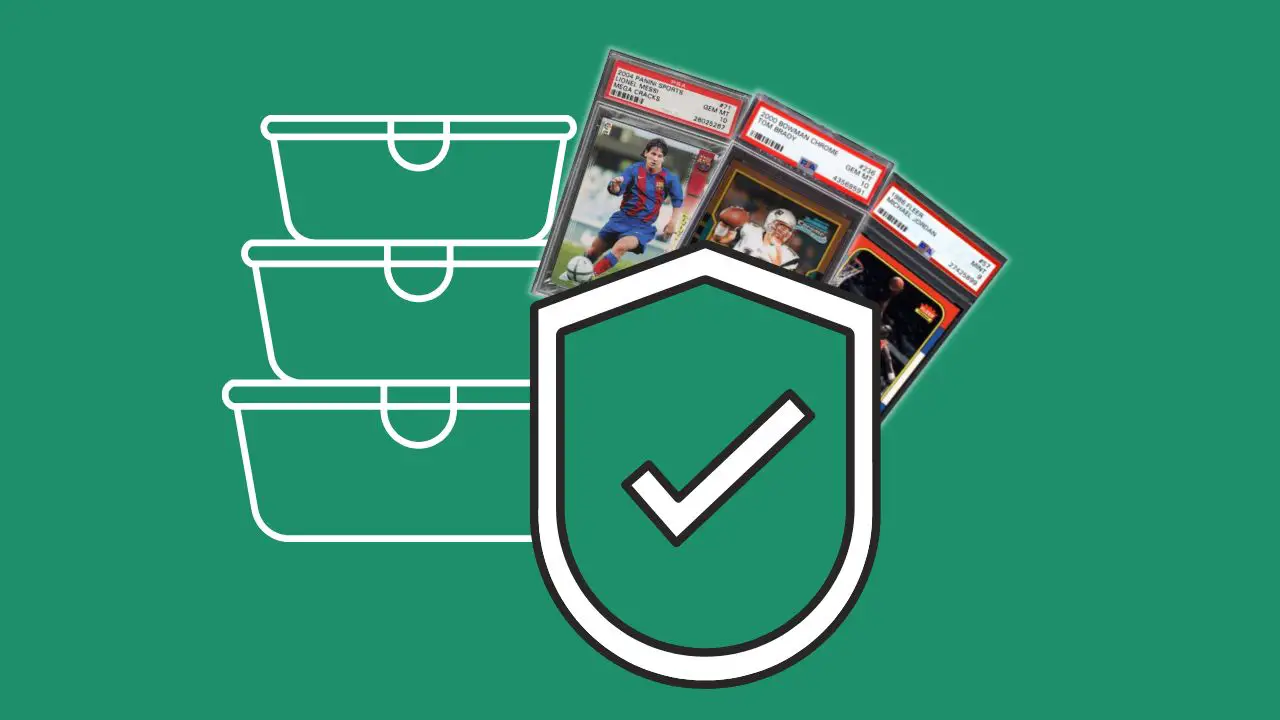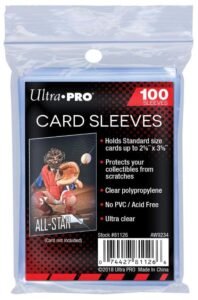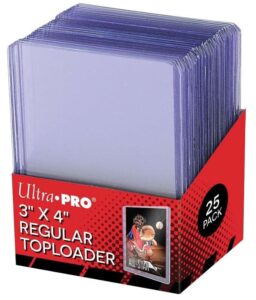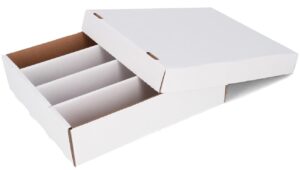
If you have a collection of sports cards, the way they are stored will have a big impact on their condition.
In short, you should store ungraded sports cards in sleeves and top loaders, before putting them inside some kind of storage case, to keep them protected. I would also then recommend storing them away from moisture and direct sunlight.
There is more to it, and I’ve gone through everything you need to know about how to properly store ungraded cards, and preserve their condition, below.
Table of Contents
Quick Summary
- Carefully place the card into a sleeve.
- Place the card (which is now inside a sleeve) into a top loader.
- Place top loaders (with cards inside) into a storage box.
- Store the box in a dry place, away from direct sunlight.
The Best Way To Store Trading Cards
Step 1 - Card Sleeves
The first layer of protection for a sports card should be a card sleeve.
Unless the card is freshly pulled from a pack or box set, it’s always best practice to carefully clean the surfaces of a card with a microfiber cloth, to make sure there’s no dust or residue that can cause surface damage, before putting it into a sleeve.
A card sleeve will protect the card’s surface, and allow you to handle it without worrying about leaving fingerprints, which can negatively affect its condition – always try and lightly hold the card on its edges, and avoid touching the surface, when sleeving it.

Step 2 - Top Loaders
The next level of protection for a sports card is a top loader.
The rigid plastic cover offers the card further protection against bending or tearing, for example, and is commonly used now for storing trading cards of any kind.
It’s important to take care when putting a sleeved card into a toploader – the best practice is not to push the card down into the toploader, it’s best to slightly insert the sleeved card (while lightly squeezing the sides of the toploader to open it up) and then gently tap it on a table, so that the sleeved card will fall into place without damage.
Take a look at our pick of the best quality top loaders here.

Step 3 - Card Storage Boxes
Once your cards have multiple levels of protection against damage, with card sleeves and toploaders, the next step is to put them into a card storage box.
Card storage boxes can usually hold a high number of cards, and help keep them separated and secured in place.
Once the cards are in the storage box, you can go one step further, for highly valuable cards, and put the box into a fireproof safe, in case of a worst case scenario.

Step 4 - Keep Away From Moisture And Direct Sunlight
Once you’ve taken the necessary steps to protect your cards from surface damage, you should also make sure they’re kept in a dry place, and away from direct sunlight.
Moisture will cause both damage and warping, and sunlight will make the card’s colors fade, so it’s important to store trading cards away from both; Cards in a sleeve and top loader can still be prone to damage from both.
Should You Sleeve All Sports Cards?
Card sleeves are cheap and the most easy way to give a card a basic layer of protection against surface damage and fingerprints, so I personally sleeve all the sports cards I care about and want to preserve.
If you have cards that aren’t valuable, and you’re not bothered about the condition of for whatever reason, then you don’t necessarily need to sleeve them, but it’s best practice now and common for collectors to sleeve all their cards.
Should I Laminate My Sports Cards?
If you care about the value of a sports card, do not laminate them. It may seem like a good idea to protect the card by laminating, but it’ll completely take the value away from it, should you go to sell it.
A good alternative is a card binder or a card sleeve and toploader.
Do Sleeves Protect Cards?
Card sleeves do give a card some basic surface protection against scratches, dust and fingerprints, for example.
It’s recommended that sleeved cards are also put into a top loader for further protection against bending and tearing.
What Are The Best Sleeves For Sports Cards?
Card sleeves are perfect for protecting basic sports cards. For thicker sports cards, that have a jersey patch for example, it’s best to use a bigger sleeve.
A popular card sleeve brand among collectors is Ultra Pro – their card sleeves are cheap and reliable.
There are many brands out there, but Ultra Pro is who many card collectors turn to, including myself, and you can’t fault them.
Can Card Sleeves Damage Sports Cards?
While penny sleeves are perfect for protecting sports cards, they can actually damage a card if used incorrectly.
Trying to fit a card that’s too big into a standard penny sleeve will potentially damage it by bending.
A card also can also get scratched, particularly chrome cards, inside a sleeve if there’s residue or dust left inside the sleeve – it’s recommended to use new sleeves for a card rather than reusing old ones to avoid that issue, they’re not expensive, so it’s worth doing.
Why Are They Called Penny Sleeves?
A regular, thin card sleeve is sometimes referred to as a ‘penny sleeve’ due to their low cost.
Final Thoughts
Experienced collectors will know that storing trading cards properly is important to preserve them long term, and avoid them getting damaged from surface scratches, bending/warping, moisture, color fading, and so on.
A slight deterioration in a card’s condition can have a big impact on its value, or potential grade it can receive from a professional grading company, so it’s important to take the necessary steps to keep them protected from damage.

